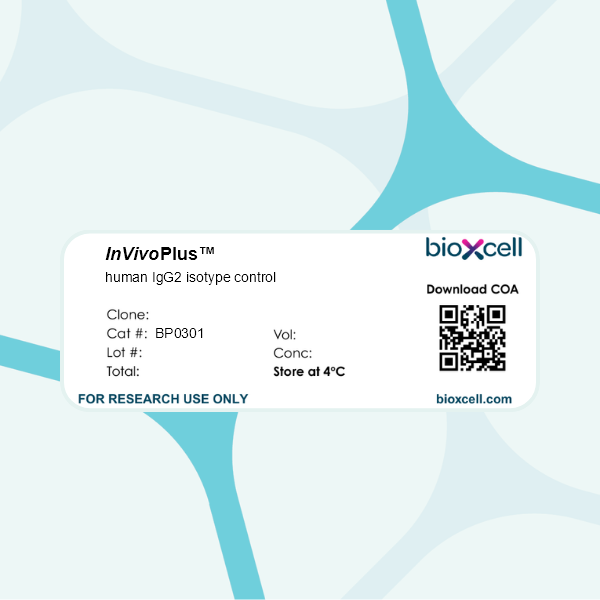InVivoPlus human IgG2 isotype control
Product Description
Specifications
| Isotype | Human IgG2, λ |
|---|---|
| Recommended Dilution Buffer | InVivoPure pH 7.0 Dilution Buffer |
| Conjugation | This product is unconjugated. Conjugation is available via our Antibody Conjugation Services. |
| Formulation |
PBS, pH 7.0 Contains no stabilizers or preservatives |
| Endotoxin* |
≤0.5EU/mg (≤0.0005EU/μg) Determined by LAL assay |
| Aggregation* |
<5% Determined by DLS |
| Purity |
≥95% Determined by SDS-PAGE |
| Sterility | 0.2 µm filtration |
| Purification | Protein A |
| RRID | AB_2715459 |
| Molecular Weight | 150 kDa |
| Murine Pathogen Tests* |
Ectromelia/Mousepox Virus: Negative Hantavirus: Negative K Virus: Negative Lactate Dehydrogenase-Elevating Virus: Negative Lymphocytic Choriomeningitis virus: Negative Mouse Adenovirus: Negative Mouse Cytomegalovirus: Negative Mouse Hepatitis Virus: Negative Mouse Minute Virus: Negative Mouse Norovirus: Negative Mouse Parvovirus: Negative Mouse Rotavirus: Negative Mycoplasma Pulmonis: Negative Pneumonia Virus of Mice: Negative Polyoma Virus: Negative Reovirus Screen: Negative Sendai Virus: Negative Theiler’s Murine Encephalomyelitis: Negative |
| Human Pathogen Test Results |
Hepatitis B Surface Antigen: Negative Human Immunodeficiency Virus 1 antibodies: Negative Human Immunodeficiency Virus 2 antibodies: Negative Hepatitis C Virus antibodies: Negative * These tests cannot guarantee the absence of infective agents |
| Storage | The antibody solution should be stored at the stock concentration at 4°C. Do not freeze. |
| Need a Custom Formulation? | See All Antibody Customization Options |
Product Citations
-
-
Neuroscience
Recurrent infections drive persistent bladder dysfunction and pain via sensory nerve sprouting and mast cell activity.
In Sci Immunol on 1 March 2024 by Hayes, B. W., Choi, H. W., et al.
PubMed
Urinary tract infections (UTIs) account for almost 25% of infections in women. Many are recurrent (rUTI), with patients frequently experiencing chronic pelvic pain and urinary frequency despite clearance of bacteriuria after antibiotics. To elucidate the basis for these bacteria-independent bladder symptoms, we examined the bladders of patients with rUTI. We noticed a notable increase in neuropeptide content in the lamina propria and indications of enhanced nociceptive activity. In mice subjected to rUTI, we observed sensory nerve sprouting that was associated with nerve growth factor (NGF) produced by recruited monocytes and tissue-resident mast cells. Treatment of rUTI mice with an NGF-neutralizing antibody prevented sprouting and alleviated pelvic sensitivity, whereas instillation of native NGF into naïve mice bladders mimicked nerve sprouting and pain behavior. Nerve activation, pain, and urinary frequency were each linked to the presence of proximal mast cells, because mast cell deficiency or treatment with antagonists against receptors of several direct or indirect mast cell products was each effective therapeutically. Thus, our findings suggest that NGF-driven sensory sprouting in the bladder coupled with chronic mast cell activation represents an underlying mechanism driving bacteria-independent pain and voiding defects experienced by patients with rUTI.
-
-
-
Biochemistry and Molecular biology
-
Genetics
Highly secreted tryptophanyl tRNA synthetase 1 as a potential theranostic target for hypercytokinemic severe sepsis.
In EMBO Mol Med on 1 January 2024 by Kim, Y. T., Huh, J. W., et al.
PubMed
Despite intensive clinical and scientific efforts, the mortality rate of sepsis remains high due to the lack of precise biomarkers for patient stratification and therapeutic guidance. Secreted human tryptophanyl-tRNA synthetase 1 (WARS1), an endogenous ligand for Toll-like receptor (TLR) 2 and TLR4 against infection, activates the genes that signify the hyperinflammatory sepsis phenotype. High plasma WARS1 levels stratified the early death of critically ill patients with sepsis, along with elevated levels of cytokines, chemokines, and lactate, as well as increased numbers of absolute neutrophils and monocytes, and higher Sequential Organ Failure Assessment (SOFA) scores. These symptoms were recapitulated in severely ill septic mice with hypercytokinemia. Further, injection of WARS1 into mildly septic mice worsened morbidity and mortality. We created an anti-human WARS1-neutralizing antibody that suppresses proinflammatory cytokine expression in marmosets with endotoxemia. Administration of this antibody into severe septic mice attenuated cytokine storm, organ failure, and early mortality. With antibiotics, the antibody almost completely prevented fatalities. These data imply that blood-circulating WARS1-guided anti-WARS1 therapy may provide a novel theranostic strategy for life-threatening systemic hyperinflammatory sepsis.
-
-
-
Biochemistry and Molecular biology
-
Cardiovascular biology
PCSK9 acts as a key regulator of Aβ clearance across the blood-brain barrier.
In Cell Mol Life Sci on 27 March 2022 by Mazura, A. D., Ohler, A., et al.
PubMed
Despite the neurodegenerative disorder Alzheimer's disease (AD) is the most common form of dementia in late adult life, there is currently no therapy available to prevent the onset or slow down the progression of AD. The progressive cognitive decline in AD correlates with a successive accumulation of cerebral amyloid-β (Aβ) due to impaired clearance mechanisms. A significant percentage is removed by low-density lipoprotein receptor-related protein 1 (LRP1)-mediated transport across the blood-brain barrier (BBB) into the periphery. Circulating proprotein convertase subtilisin/kexin type 9 (PCSK9) binds to members of the low-density lipoprotein receptor protein family at the cell surface and targets them for lysosomal degradation, which reduces the number of functional receptors. However, the adverse impact of PCSK9 on LRP1-mediated brain Aβ clearance remains elusive. By using an established BBB model, we identified reduced LRP1-mediated brain-to-blood Aβ clearance due to PCSK9 across different endothelial monolayer in vitro. Consequently, the repetitive application of FDA-approved monoclonal anti-PCSK9 antibodies into 5xFAD mice decreased the cerebral Aβ burden across variants and aggregation state, which was not reproducible in brain endothelial-specific LRP1-/- 5xFAD mice. The peripheral PCSK9 inhibition reduced Aβ pathology in prefrontal cortex and hippocampus-brain areas critically involved in memory processing-and prevented disease-related impairment in hippocampus-dependent memory formation. Our data suggest that peripheral inhibition of PCSK9 by already available therapeutic antibodies may be a novel and easily applicable potential AD treatment.
-

